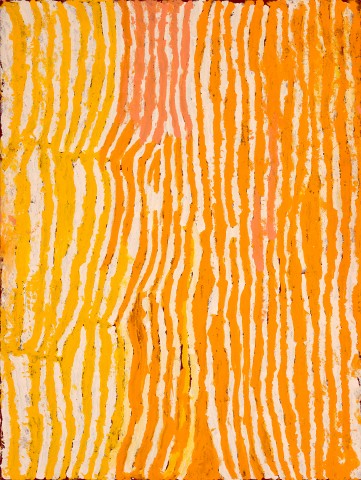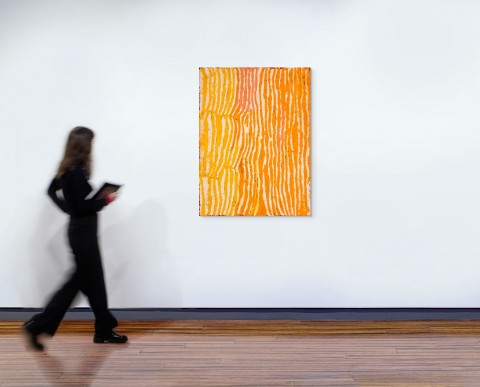UNTITLED, 2007
MAKINTI NAPANANGKA
synthetic polymer paint on Belgian linen
122.5 x 92.0 cm
bears inscription verso: artist’s name, size and Papunya Tula Artists cat. MN0701158
Papunya Tula Artists, Alice Springs, Northern Territory
Private collection, Melbourne, acquired in 2007
The richly-coloured expressive compositions of senior Pintupi artist Makinti Napanangka act as visual recollections of the artist’s deep cultural understanding and authority, with each of her painterly compositions visually encoded with Pintupi ancestral and ceremonial knowledge. Recurring across her oeuvre Napanangka depicted the designs associated with the rock hole site of Lupulnga, over which she had custodial rights. Through her compositions of sweeping and wavering linear planes in the shades of yellow, orange, blue and white, Napanangka translates elements related to the cultural stories of the Peewee (small bird) Dreaming and the travels of the Kungka Kutjarra (Two Ancestral Women) associated with this ceremonial site of Lupulnga.
Napanangka joined Papunya Tula Artists in 1996 and prior to her death in 2011, was the most senior woman painting with Papunya Tula Artists. Stylistically, as reflected by Hetti Perkins, the visual language of Napanangka’s works owe ‘more to the gesture of hand-painting ochre onto the body for women’s ceremonies, than to the meticulous application of dots that characterises men’s ceremonial and contemporary art making.’1
The undulating and twisting forms that denote Untitled, 2007, exemplifies Napanangka’s haptic and rhythmic approach. In this work, Napanangka reflects her mastery in enlivening the gently entwined and flowing gestural linear bands of alternating yellow, white and orange hues, in an artistic gesture to echo the movement of the spun hair-string skirts (nyimparra), worn in Pintupi women’s ceremonies, in reference to the Kungka Kutjarra. As Perkins states ‘the celebratory nature of these performances is expressed in the hedonistic play of colour and form across the painting’s surface.’2
1. Perkins, H., Tradition Today: Indigenous Art in Australia, Art Gallery of New South Wales, Sydney, 2004, p. 108
2. ibid.
GEORGIE LATHAM

